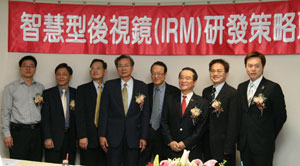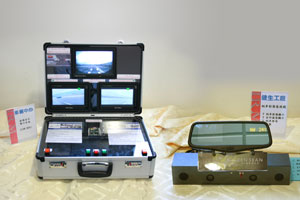Intelligent Rearview Mirror Reflects ARTC's Latest Ambition in Taiwan
2009/04/20 | By Quincy LiangThe mundane rearview mirror in cars certainly has come a long way since the days when a driver had to manually adjust it just for night viewing. Certain upscale cars already integrate other functions into the rearview mirror, one of the most used and convenient driving aides within a driver's line of sight, but an officially-sponsored automotive R&D arm in Taiwan is in the process of developing the rearview mirror into a multifunctional instrument as convenient to use as a heads-up display windshield, with the rearview mirror of the future to be a driving information and assisting platform.

The government-sponsored (subsidized by the Science & Technology Development Project from the Ministry of Economic Affairs) IRM project aspires to, within two years, integrate into a rearview mirror a host of driver-assist systems and information displays via a built-in LCD-commercializing an IRM that doubles as a parking assist system (PAS) or auto parking system, frontal anti-collision warming system, door-ajar warming system, lane departure warning system, ETC, TPMS etc.
Ambitious Goal
Upmarket carmakers as Volvo and BMW offer such IRM but only with one or two of the said functions or systems; while the IRM R&D Alliance is trying to outdo the existing by integrating seven functions (sub-systems) into one IRM.
Having the right members in the alliance paves the way properly for successful commercialization of the IRM. Ken Sean, for example, is a major global original equipment (OE) mirror supplier to many auto and motorcycle brands, which could set up ready-made distribution channels for the IRM. In addition, CMC, the long-term No. 2 auto seller in Taiwan and a major car exporter, could adopt the IRM on its cars or road test it to build reliability record, critically important in the automotive supply chain.
As both a director and experienced participant, the ARTC would supply the alliance with testing and R&D capability related to automotive safety systems as well as expertise in automotive image-display to develop the IRM.

Besides driven by its inherent mission, the ARTC likely also sees promise in developing the IRM: Quoting statistics compiled by foreign market-research firms, the ARTC says that the automotive-imaging and -camera market value is estimated to jump from US$350 million in 2008 to US$950 by 2011. Over the next two years, the alliance will invest about NT$150 million (US$4.3 million at US$1: NT$35) into the IRM R&D.
Joe Huang, ARTC president, claims that the center has been aggressively upgrading its R&D capability, especially related to automotive safety and intelligent driving systems in recent years. "Our goal is not only to innovate increasingly more intelligent automotive systems, but also set market trends," confidently says Huang. "The center has successfully, steadily developed several innovative and advanced systems, and we can stay in line with the global trend by integrating them into a device like the IRM. Our efforts can simultaneously upgrade driving safety and convenience, as well as create a brand-new market segment for auto-parts makers in Taiwan."
According to Huang, the ARTC underwent mostly construction during 2000 and 2005 to outfit facilities, while the staff now are upgrading the ARTC into a key engineering center in Asia by investing every available resource to enhance R&D capability; for after all a testing center is only as good as its R&D capacity. To achieve the center's new goal, the ARTC will raise its staff from the current 340 to around 370 in one to two years, with most of the new recruits to be R&D personnel.
ARTC's to-be-built IRM vs. Others | |||||||
Maker | Parking Assist System | Frontal Anti- collision | Blind- spot Warning | Lane Departure Warning System | Door- ajar Warning | Tire Pressure Monitoring System | Electronic Toll Collection |
Luxgen | ● | ● | ● | ||||
Volvo | ● | ● | ● | ● | |||
Lexus | ● | ● | ● | ||||
BMW | ● | ● | ● | ||||
Infiniti | ● | ● | |||||
OPEL | ● | ||||||
Mobileye | ● | ● | ● | ||||
Valeo | ● | ● | |||||
Continental | ● | ||||||
Smart Micro | ● | ● | ● | ||||
Murakami | ● | ||||||
ARTC's | ● | ● | ● | ● | ● | ● | ● |
Source: ARTC. | |||||||




